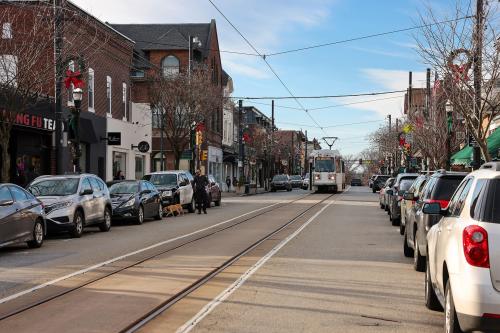A version of this piece was first published by ProMarket.
By now, it’s clear that “Bidenomics” centers heavily on what the White House calls a “modern American industrial strategy.” What’s less recognized, though, is another feature of the new economic push: its strong geographic orientation.
Most broadly, the big spending bills of the last Congress—the American Rescue Plan Act (ARP), Infrastructure Investment and Jobs Act (IIJA), CHIPS and Science Act, and Inflation Reduction Act (IRA)— embody a national pivot. The U.S. has recommitted to a broad public investment agenda after decades of vacillation between “laissez-faire” economics at some times and redistributive efforts at others. The new goal: Raise the productive capacity of the U.S. economy and at the same time promote greater inclusion, a higher standard of living, and reduced carbon emissions.
And yet, there is more to the new line of action. Specifically, key elements of the new approach are strongly place-based.
That is, they propose to achieve broader national goals through deliberate and direct investments into specific U.S. places and regions. In this vein, the Brookings Metro counts 19 explicitly place-based industrial policy programs—adding up to some $80 billion of authorized spending—distributed across three of the four previously mentioned pieces of legislation (ARP, IIJA, and CHIPS and Science). Billions more in clean-tech subsidies and awards from the IRA for green growth—while not explicitly place-targeted—will also benefit the nation as a whole by benefiting particular places, such as the emerging “battery belt.”
Which is why the new “place-based industrial strategy” merits serious consideration as a compelling approach to economic development—especially for a nation with deep regional divides and large pools of underutilized talent and capacity. Broad national programs or universal stances like laissez-faire have their value, but they often lack the focus to confront entrenched local market failures. Place-based strategies, however, may be able to engage more directly and efficiently with the roots of problems and the needs of individuals and firms in local communities. In that fashion, the new policies seek to boost the national economy by investing to help local economies, whether by supporting regional innovation clusters or financing creative workforce partnerships. In sum, “place-based” industrial strategies very much merit the attention they are beginning to receive.
History—and new concerns—warrant this experiment
Both historical precedents and newer concerns underscore this experiment with place-based industrial policy, whether through competitions to site regional tech hubs or by subsidizing semiconductor plants in new places.
Alexander Hamilton, for one, engaged locally as well as nationally when he persuaded the state of New Jersey to provide public support to develop a “national manufactory.” Ultimately, Hamilton’s broad vision of industrial policy was advanced in part through the local creation of a planned city called Paterson, which leveraged the water power of the nearby Great Falls to support the emergence of a network of factories nearby.
More recent examples of place-based industrial policy include the expansive geographic transformations driven by national “big pushes” such as publicly financed, locally targeted manufacturing plants during World War II or high-tech spending in localities during the space race. Again, national goals were achieved by local investments that delivered national benefits as well as regional ones.
For example, Andrew Garin and Jonathan Rothbaum recently demonstrated that during World War II, government-funded factory openings in local communities catalyzed a persistent expansion of high-wage manufacturing work in those places, which supported permanent increases in regional employment and long-term economic mobility—with the largest effects felt by the children of parents with lower earnings. The authors note the Willow Run bomber plant in Ypsilanti, Mich. as a classic case of a large war plant massively transforming a city for decades to come. For their part, Shawn Kantor and Alexander Whalley quantified the substantial effects of public space race R&D on long-term economic growth for both local economies and the national economy.
In the last two decades, meanwhile, a series of interconnected trends has motivated a new search for more robust and geographically focused responses to challenging problems. For example, decades of stagnant productivity growth, slippage in the competition with China, rising economic inequality, and climate crises have undercut confidence in business-as-usual economic management and prompted interest in more direct interventions.
At the same time, the nation’s widening regional divides—sharpened by the “winner-take-most” dynamics of the digital economy—have thrown even more attention on the potential of place-based policymaking.
In this regard, the results of the 2016 election underscored the nation’s geographic crisis and prompted a surge of place-oriented policy work, including from hitherto skeptical economists. This welcome burst of attention, paired with advances in both theory and practice, has led to a broad reassessment of place-based economic development. And now that reassessment is reflected in the major economic policies of the Biden administration. The industrial policy bills of the last Congress represent the most significant American test of place-based ideas since the Great Society—or maybe even the New Deal.
Three reasons for testing ‘place-based’ strategies
That test is well worth embarking on, for three reasons. First, place-based strategies can target the specific location and detail of a market problem, such as a workforce training gap or the emergence of particular “left-behind” places. In that sense, place-based strategies allow for a tighter focus on where and what the problems are.
Second, by supporting grounded problem-solving, place-focused strategies can get at the local and “micro” underpinnings of “macro” performance issues more readily than broader, universal policies. Many of the new programs intervene in what Gary P. Pisano and Willy Shih call the nation’s “industrial commons”: the place-based concentrations of research institutions, skilled workers, and suppliers that anchor America’s most competitive industries. In this way, place-based industrial policy invests locally to address gaps in local clusters or entrepreneur-support systems by intervening with the most immediately relevant actors, networks, and institutions.
And third, “place-oriented” policies are more likely to get the civics right, especially when they enlist and catalyze local “bottom-up” problem-solving. As my colleagues and I previously observed, transforming a regional economy requires mobilizing a wide variety of local actors, networks, and knowledge flows. And it requires maintaining political support—ideally bipartisan. Place-based programs that engage with the issues and needs of local talent, clusters, institutions, and ecosystems will be more likely to succeed at this than more disembodied programs. They will also be more likely to create useful civic and political coalitions that move to address challenges in new ways.
But to be sure, there are risks to be weighed. One knock on place-based industrial policy is that the geographic biases of politics will make it inefficient. Won’t the political geography of elections, or of Congress, inevitably skew decisionmaking about the siting of investments in projects like a regional clean hydrogen hub? Maybe, but likely not significantly. The recent history of numerous grant programs, such as those of the National Science Foundation, allow for a degree of confidence that carefully designed, well-insulated programs utilizing expert peer review processes can make awards effectively.
Others worry about the potential of many American places to increase their productivity—they doubt, sometimes privately, that some communities can ever truly be revitalized. To this, it bears acknowledging that much work needs to be done to enhance the readiness of local regions, including transforming fragmented systems and encouraging new and locally appropriate development work. With that said, it’s also true that the government’s demanding criteria for proposals and the competitive nature of virtually all the new place-based programs are already mobilizing hundreds of regions and consortia around the country, lifting aspirations, and disciplining against “business-as-usual.” The government’s call for ambitious but grounded ideas—and strict selection criteria—will likely nudge many communities onto a new growth path.
Which raises a final note: Now that these programs have been authorized and mostly funded, what is needed is for Congress and the Biden administration to build out the experiment. Congress should fill in several appropriation gaps, while federal agencies should continue to effectively implement the new programs and rigorously evaluate how well they work. In that sense, the nation’s new array of place-based industrial programs represents an excellent opportunity to test a region-first approach to economic development.
The Brookings Institution is committed to quality, independence, and impact.
We are supported by a diverse array of funders. In line with our values and policies, each Brookings publication represents the sole views of its author(s).




Commentary
Biden’s big bet on place-based industrial policy
March 6, 2023